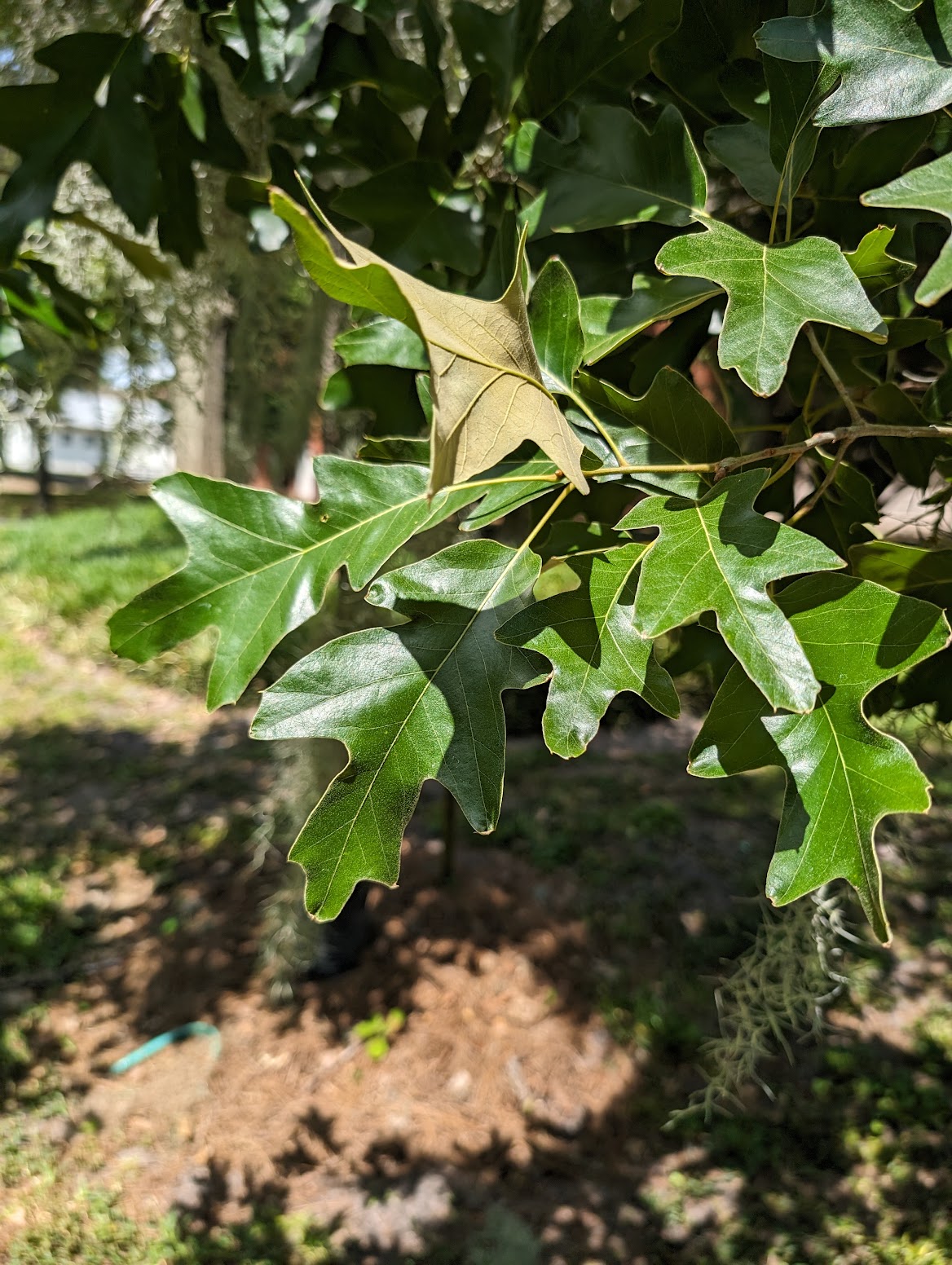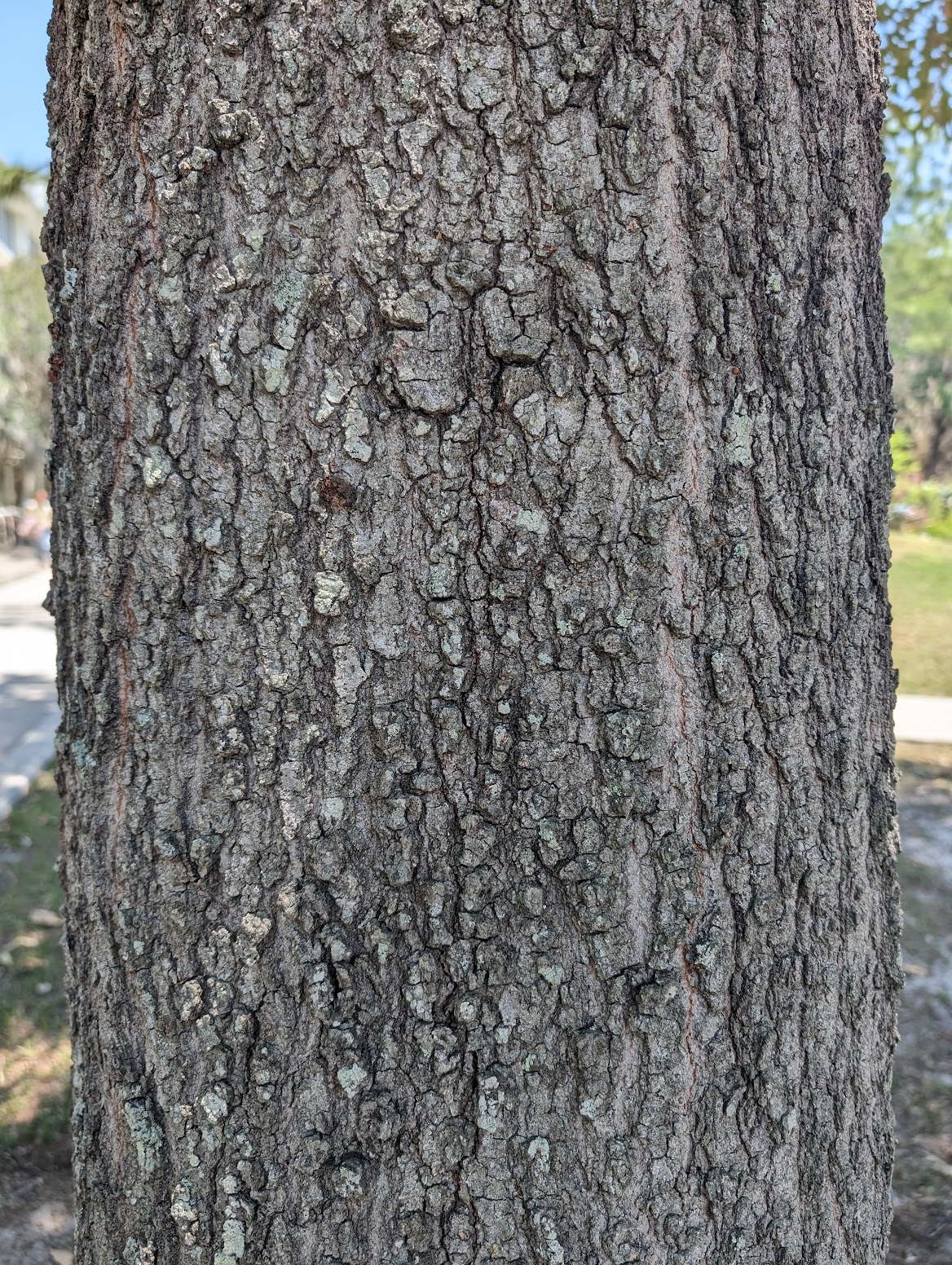Fagaceae - Beech Family
In 2024, this southern red oak measured 50 feet tall and had a diameter of 18 inches. Based on USDA Forest Service models, it will absorb approximately 1,857 lbs. of carbon over the next 20 years. Put simply, this tree alone will offset up to 7,516 miles worth of carbon dioxide.
See all species on our Campus Tree Tour.
Introduction
Southern red oaks, native to the Southeastern United States, are long-lived trees with straight trunks and wide spreading crowns. In Florida, these trees are some of the only oaks that display vibrant fall colors, making them attractive landscape and city trees. In natural settings, the southern red oak’s leaf litter enriches the soil with organic nutrients, while its acorns serve as a food source for wildlife.
Physical Description
Life expectancy: 150-275 years
Height: 60-80 feet
Crown: 60-70 feet
Diameter: 24-36 inches
Bark: Smooth and grey when young but develops to become black and furrowed.
Leaves: Leaves are green and deciduous with 3-7 lobes that end with bristle tips at the end of each lobe. Alternately arranged along twigs and with tannish hairs on the underside of each leaf with petioles 1-4 cm in length. Leaf base with distinct “U”/ “V” shape.
Twig: Will have a cluster of buds at the very end of the twig, which signifies that the plant is an oak. Twigs also have hairs.
Flowers: Yellow-green catkins (male flowers) and small spike flowers (female) are produced in April-May.
Fruits: Brown acorns that are ovoid in shape typically 1 inch in length. The acorn cap covers 1/3 of the acorn.
Key Identification Characteristics: Lobed leaf with tannish hairs on the underside, distinct “U”/ “V” shape on leaf base with a long petiole, dark furrowed bark.
Past and Present Uses
Historically, the southern red oak had similar uses to other oak species. Its wood was used as timber and firewood, while its acorns were a food source. The oak’s leaves and bark, both rich in tannins, were used for dyes.
Currently, southern red oaks are primarily valued for their appearance and shade and are used with limited frequency in hardwood markets. When planted in urban environments, their crown and root growth require careful maintenance because their abundant leaf litter encourages regular cleaning, and their roots can push against sidewalks.
Ecological Importance
Origin: Native to the United States
Native Range: Found from New York south to Marion County in Florida and then westwards to Texas and eastern Oklahoma.

Figure 1. Native range of Southern Red Oak. Photo credit: U.S. Geological Survey
Southern red oaks are found in several ecosystems within Florida ranging from dry to moist soils. In Florida, they grow in red oak sandhill ecosystems as well as deciduous hardwood forests. These trees are typically seen growing along other hardwoods and pines like loblolly pines, longleaf pines, swamp chestnut oaks, white oaks, and hickories.
The spreading crowns of these oaks offer nesting habitats for birds and when the trunks begin to rot, they provide habitats for small mammals. The trees also act as a larval host for butterflies and moths such as the banded hairstreak and white hairstreak. Acorns also provide food for many animals including squirrels, songbirds, deer, turkey, and black bears.
More Information
https://edis.ifas.ufl.edu/publication/ST546
References
Ask IFAS - Powered by EDIS. (2018, December). Enh-704/ST546: Quercus falcata: Southern Red Oak. https://edis.ifas.ufl.edu/publication/ST546
Godfrey, R. K., & Darst, M. (1988). Trees, shrubs, and woody vines of northern Florida and adjacent Georgia and Alabama. University of Georgia Press.
Plant database. Lady Bird Johnson Wildflower Center - The University of Texas at Austin. (n.d.). https://www.wildflower.org/plants/result.php?id_plant=qufa
Quercus falcata. Florida Native Plant Society (FNPS). (n.d.). https://www.fnps.org/plant/quercus-falcata
Belanger, Roger P. United States Department of Agriculture. (n.d.). Southern Red Oak. Quercus falcata Michx. https://www.srs.fs.usda.gov/pubs/misc/ag_654/volume_2/quercus/falcata.htm
Varma, Y., & Tran, M. (n.d.). Southern Red Oak. Glen Arboretum. https://wp.towson.edu/glenarboretum/home/southern-red-oak/



